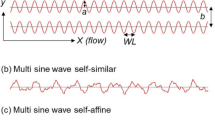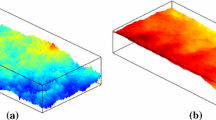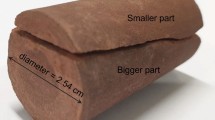Abstract
The hydro-mechanical response of fractured rock masses is complex, due partly to the presence of fractures at different scales. Surface morphology has a significant influence on fluid flow behaviour of a fracture. Different empirical correlations and statistical models have been proposed to estimate the equivalent hydraulic aperture and determine the pressure drop along a fracture. However, the existing models suffer from not being adequately generalised to be applicable to a wide range of real fracture surfaces. To incorporate the effect of profile roughness in the hydro-mechanical behaviour of fractured rock masses, the joint roughness coefficient (JRC) is the most widely used empirical approach. However, the average JRC of two fracture walls in fluid flow analysis, as is a common practice, appears to be inappropriate. It will be shown how different combinations of pairs of JRCs could lead to a similar JRC value. Also, changing the position of the top and bottom walls of a fracture can significantly change the hydraulic response of the fracture while the average JRC is identical in both cases. In this paper, correlations are developed which are based on the simulation of JRCs using estimated fluid flow parameters of 2D fractures can be estimated. In order to widen the application range of the correlations, JRC flow channels were generated: these are 2D channels with their top and bottom walls being made from two of the JRC profiles. To estimate the JRC of linear profiles, a correlation developed between JRC and a newly developed Riemannian roughness parameter, D R1, is proposed. Considering ten JRC profiles, a total of 100 JRC flow channels were generated. In order to only investigate the effect of surface roughness on fluid flow, the minimum closure between the top and bottom walls of JRC flow channels were considered to be constant. Three cases with minimum closures of 0.01, 0.05 and 0.10 cm were considered in this study. All JRC flow channels were subjected to fluid analysis using FLUENT software. Based on these results, correlations were developed between the geometrical and hydraulic properties of flow channels. Analysis of several real fractures demonstrated the applicability of these correlations.
























Similar content being viewed by others
References
Barton N (2007) Rock quality, seismic velocity, attenuation and anisotropy. Taylor & Francis Group, London
Barton N, Choubey V (1977) The shear strength of rock joints in theory and practice. Rock Mech Rock Eng 10:1–54
Barton N, de Quadros EF (1997) Joint aperture and roughness in the prediction of flow and groutability of rock masses. Int J Rock Mech Min Sci 34:252.e1–252.e14
Barton N, Bandis S, Bakhtar K (1985) Strength deformation and conductivity coupling of rock joints. Int J Rock Mech Min Sci Geomech Abstr 22:121–140
Crandall D, Ahmadi G, Smith D (2010a) Computational modeling of fluid flow through a fracture in permeable rock. Transp Porous Med 84:493–510
Crandall D, Bromhal G, Karpyn ZT (2010b) Numerical simulations examining the relationship between wall-roughness and fluid flow in rock fractures. Int J Rock Mech Min Sci 47:784–796
Fluent Inc. (2005) FLUENT 6.3 user’s guide, Chap 3. Text user interface (TUI). P.1–2
Ge S (1997) A governing equation for fluid flow in rough fractures. Water Resour Res 33:53–61
Giacomini A, Buzzi O, Ferrero AM, Migliazza M, Giani GP (2008) Numerical study of flow anisotropy within a single natural rock joint. Int J Rock Mech Min Sci 45:47–58
Hosseinian A, Rasouli V, Utikar R (2010a) Fluid flow response of JRC exemplar profiles, European rock symposium (EUROCK 2010). Taylor & Francis Group, Lausanne
Hosseinian A, Rasouli V, Bahrami H (2010b) Analytical and numerical analysis of fluid flow through rough natural fracture profiles. In: 44th US rock mechanics symposium and 5th US–Canada rock mechanics symposium, Salt Lake City
Jaeger JC, Cook NGW, Zimmerman RW (2007) Fundamentals of rock mechanics, 4th edn. Wiley, New York
Koldiz O (2001) Non-linear flow in fractured rock: Int. J Numer Meth Heat Fluid Flow 11:547–575
Koyama T, Li B, Jiang Y, Jing L (2009) Numerical modelling of fluid flow tests in a rock fracture with a special algorithm for contact areas. Comput Geotech 36:291–303
Kulatilake PHSW (2008) Quantification of aperture and relations between aperture normal stress and fluid flow for natural single rock fractures. Geotech Geol Eng 26:269
Liu E (2005) Effects of fracture aperture and roughness on hydraulic and mechanical properties of rocks: implication of seismic characterisation of fractured reservoir. J Geophys Eng 2:38–47
Liu H, Sterling R (1990) Statistical description of the surface roughness of rock joints. The 31th US symposium. Rock Mechanics, pp 277–284
Nazridoust K, Ahmadi G, Smith DH (2006) A new friction factor correlation for laminar single-phase flows through rock fractures. J Hydrol 329:315–328
Olsson R, Barton N (2001) An improved model for hydromechanical coupling during shearing of rock joints. Int J Rock Mech Min Sci 38:317–329
Patir N, Cheng HS (1978) An average flow model for determining effects of three dimensional roughness on partial hydrodynamic lubrication. J Lubr Tech 100:12–17
Petchsingto T, Karpyn ZT (2009) Deterministic modeling of fluid flow through a CT-scanned fracture using computational fluid dynamics. Energy sources. Part A. Recovery Utilization Environ Effects 31:897
Rasouli V (2002) Application of Riemannian multivariate statistics to the analysis of fracture surface roughness: PhD thesis. Imperial College, London
Rasouli V, Harrison JP (2001) Is the observational method of roughness determination trustworthy? In: Proceedings of ISRM international symposium. Eurock 2001, Espoo, pp 277–282
Rasouli V, Harrison JP (2010) Assessment of rock fracture surface roughness using Riemannian statistics of linear profiles. Int J Rock Mech Min Sci 47:940–948
Renshaw CE (1995) On the relationship between mechanical and hydraulic apertures in rough-walled fractures. J Geophys Res 100:24629–24636
Sarkar S (2002) Fluid flow simulation in fractured reservoirs. Earth Resources Laboratory, MIoT, Cambridge
Scesi L, Gattinoni P (2007) Roughness control on hydraulic conductivity in fractured rocks. Hydrogeol J 15:201–211
Tse R, Cruden DM (1979) Estimating joint roughness coefficients. Int J Rock Mech Min Sci Geomech Abs 16:303–307
Wayne NR, Schechter DS, Thompson LB (2006) Naturally fractured reservoir characterization. SPE, Richardson
Yeo I, Ge S (2005) Applicable range of the Reynolds equation for fluid flow in a rock fracture. Geosci J 9:347–352
Zimmerman RW, Bodvarsson GS (1996) Hydraulic conductivity of rock fractures. Transp Porous Med 23:1–30
Zimmerman RW, Kumar S, Bodvarsson GS (1991) Lubrication theory analysis of the permeability of rough-walled fractures. Int J Rock Mech Min Sci Geomech Abstr 28:325–331
Author information
Authors and Affiliations
Corresponding author
Rights and permissions
About this article
Cite this article
Rasouli, V., Hosseinian, A. Correlations Developed for Estimation of Hydraulic Parameters of Rough Fractures Through the Simulation of JRC Flow Channels. Rock Mech Rock Eng 44, 447–461 (2011). https://doi.org/10.1007/s00603-011-0148-3
Received:
Accepted:
Published:
Issue Date:
DOI: https://doi.org/10.1007/s00603-011-0148-3




